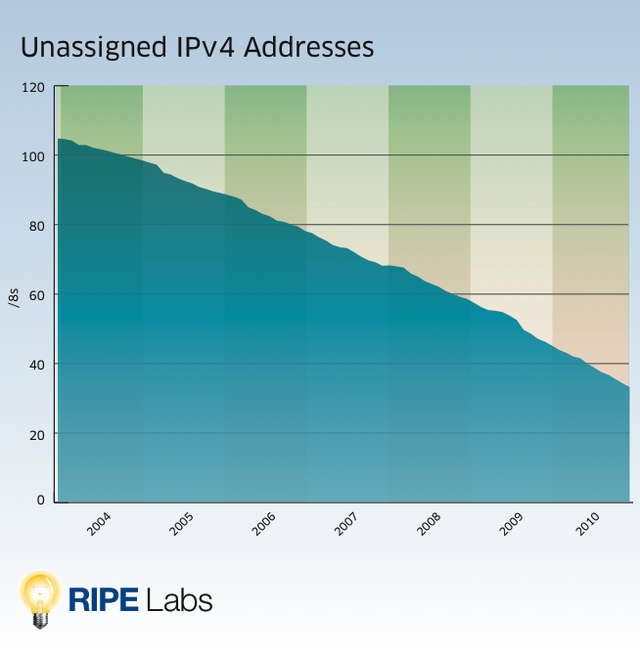With the IPv4 address space nearing its end, we are closely monitoring the number of address not yet assigned or allocated. See below one way of measuring them.
Introduction
With the free pool of IPv4 addresses nearing its end, we looked at the evolution of the amount of unassigned IPv4 address space over time. By ‘unassigned’, we mean address space not yet allocated to a Local Internet Registry (LIR) or assigned to an End User.
See our findings in the graph below.

Method
The entire IPv4 address space is comprised of 256 /8's. Parts of this space are not available because they are reserved for other purposes like multicast and private address networks, as documented in RFC5735 . The amount of such reserved IPv4 address space has been calculated by Geoff Huston to be 35.0872 /8's (See more information in the IPv4 Report ). That means the entire amount of assignable IPv4 address space is 220.9128 /8's.
To determine what is "unassigned", we define the difference between the 220.9128 /8's and the total amount of IPv4 address space the RIRs are responsible for. We looked at this difference for each date since 2004 to see how the number of unassigned addresses is shrinking over time.
All data originates from the Internet Number Resource Database (more specifically the RIR Stats file inside the INRDB ).
In more detail, the unassigned space is made up of three components:
1. The unallocated /8s held by IANA
2. Unallocated space held by the Regional Internet Registries (RIRs) (i.e. the pools of IP address space from which each RIR is assigning and allocating to the membership)
3. Unassigned addresses in legacy address space (address space that was allocated and assigned before the RIR system was established). There are some holes in this legacy address space that could potentially be assigned at some point (Note that currently the RIRs are not making assignments or allocations from this space. This might change in the future).
Results
The graph shows that the decline of IPv4 has been mostly linear. This means that the Regional Internet Registries (RIRs) have been roughly allocating ten /8s each year since 2004. There was a small decrease in allocations in 2008 (likely due to the economic crisis) before accelerating again in mid-2009.
Thirty-three unassigned /8's of IPv4 addresses remain as of 1 October 2010. A naive extrapolation would mean that the RIRs still have three years left to hand out IPv4 address space. This is no reason to relax. We have clearly entered the last phase of available IPv4 address space. In 2010 the need for IPv4 addresses exceeded the long term average. RIRs handed out thirteen /8s in the last twelve months. If this trend continues or accelerates, the lifespan of the unassigned IPv4 address space will be significantly shorter.
Also, due to the difference in the regional communities, it is likely that one region will run out of IPv4 space while another may still have more than one /8 left. For more information about the currently forecasted run-out dates per region, please refer to http://ipv4.potaroo.net or http://www.ipv4depletion.com/?page_id=4
Three years is really the upper limit. An exact run-out date is difficult to forecast, because it doesn't only depend on mathematical modeling but also on address policies.
One might wonder: ‘Why has the number of allocations been so stable over time when the number of LIRs has been increasing at the same time?’. There is no clear answer to this question. The reason is likely a combination of the increased deployment of Network Address Translations (NATs) and the increased relevance of IPv4 conservation within the RIR communities over time.





Comments 2
The comments section is closed for articles published more than a year ago. If you'd like to inform us of any issues, please contact us.
Anonymous •
"Thirty-three unassigned /8's of IPv4 addresses remain as of 1 October 2010"<br /><br />You mean 13 right? There are only 12 left and it's November..unless we assigned 20 /8's in the past month in which case we should be out of allocations about.....now :)
Anonymous •
Hi Grant,<br /><br />I assume you are referring to the unallocated addresses at IANA. We counted all address space not yet allocated or assigned, including all bits and pieces marked as 'free' in the RIR's records (also legacy address space). Obviously, they are not full /8s, but if you add them all up, you get about thirty-three /8s worth of address space.